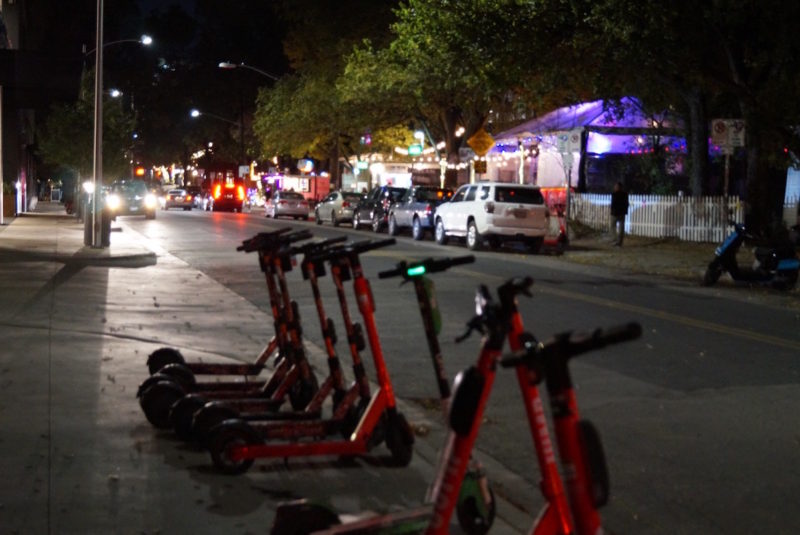Rainey Street will be closed to cars three nights a week starting December 5, turning the two lane road over to pedestrians, bicycles, and swarms of scooters.
The street, which is lined with bars, food trucks, and entertainment venues, is a popular weekend destination. The decision to ban cars from the road came after a woman riding a scooter was hit by a car in June and taken to hospital.
In the aftermath of that incident, the City Council asked city staff to pilot nighttime closures of the street while also considering running electric shuttles from Rainey to offsite parking facilities.
Now the Austin Transportation Department (ATD) is planning to move ahead with a pilot closure without the proposed electric shuttles. Cars, horse-drawn carriages, and pub crawlers will be barred from the busiest part of the street. The Department initially also planned to ban scooters, but now it says it will allow them.
“There has been rapid growth in the area and that has put a lot of pressure on the mobility infrastructure. There is a lot of mixing of modes and that can create conflict,” said Liane Miller, ATD Senior Business Process Consultant, in a presentation to the City’s Bicycle Advisory Council on Nov. 19.
She said that pedestrian volumes peak on Rainey Street at 11:00 p.m., with 900 people and over 100 cars on a mere two-block area. On a typical Friday or Saturday night there are more than 7,000 pedestrians on the road throughout the night.
Miller pointed to concern over how nighttime congestion affects emergency response times. “Access points are limited due to the geography and where the district is oriented in downtown. There are emergency access concerns of just getting emergency vehicles to the area in those cases.”
Though Rainey Street will be closed for only a few blocks from Davis Street to River Street, it’s reasonable to expect a pickup in scooter activity, as bar-goers opt out of rideshares like Uber or Lyft and try to head home directly on a scooter, or else use one as an interim mode of transit to get from a bar to a rideshare staging area.

There will be loading and unloading for taxes and rideshares from designated queuing areas at River Street on the south end of Rainey, and near Hotel Van Zandt and in front of the Lustre Pearl on the north end.
Miller said, “We don’t want to have scooter clutter at the end of the evening. We are going to work with the scooter companies to make sure they are managing their assets at the end of the closure (at 2:30 a.m) and that they’re not in the streets.”

The City is open to changing the plan if it doesn’t go well. Miller said, “I think if we see this northern section isn’t working, or there are a lot of conflicts, we could potentially extend the closure all the way to Driskill St. If we’re having issues within the closure – that would be something that Austin Police would be looking at, whether they’re having behavior problems with scooters or whatever – then they’ll consider whether or not they would want to limit it within the closure.”
The closure will be piloted from Dec. 5 to March 8, ending just prior to South by Southwest, when the street is closed anyway. But it could resume permanently after that conference ends, depending on how the pilot goes. “We’re going to be stopping because we’re going to be doing the SXSW closure, which is a different configuration at different times of day. But that doesn’t mean we couldn’t pick up the pilot for permanent closure after SXSW,” Miller said.
The City plans to send out mailers soon to about 1,300 addresses in the Rainey area to explain how the road closure will work. City staff also plan to conduct business and resident satisfaction surveys to gauge their views.
Potential Model for Other Street Closures
If the Rainey Street pilot goes well, it could serve as a model for the creation of other pedestrian thoroughfares in Austin.
The Bicycle Advisory Council, in a draft resolution Nov. 19, recommended “initiating similar shared street pilots in the entertainment areas on W. 6th Street and 6th Street east of I-35, on Red River, Congress Avenue, the Warehouse District, and in all areas with high pedestrian volumes.”
The advisory group opted to strike this language from their final passed resolution because it was not germane to the agenda item they were considering, which related only to Rainey Street. But members suggested that they would raise it again later.
“People walking and riding bicycles, pedicabs, and scooters [should] have continued, uninterrupted access at all times to the Rainey Street district including Rainey, Red River, Driskill, Davis and River streets and the connecting alleyways,” says the resolution.
